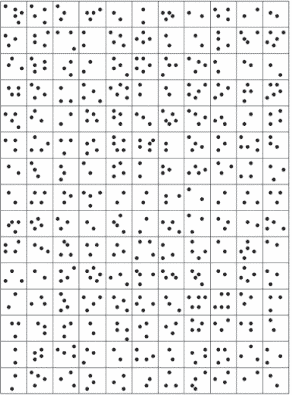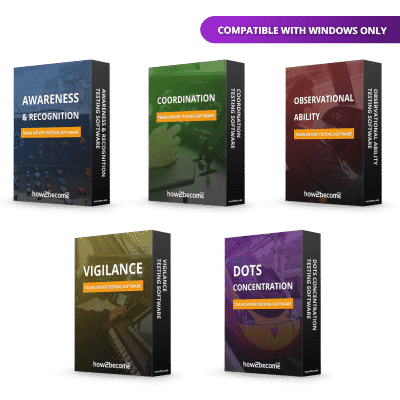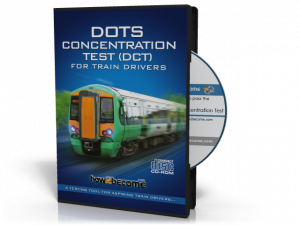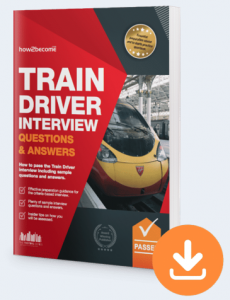If you are short-listed on the basis of your written application you will be invited to take the following train driver psychometric assessments:
- Group Bourdon Test
- TEA-OCC
- TRP 1
- TRP 2
- WAFV
- ATAVT
- 2 Hand Coordination
- SJE
- MMI
They like to do the assessments in this order because this is the order of probability in which candidates are likely to fail – so it minimises the number they need to bother with at the next stage, however, this is subject to change. If the interviews take place on the same day as the psychometric tests, they will probably take place after lunch when those who have failed the psychometric tests have been sent home. However, these things may take place at different locations, so don’t be surprised if the whole process is spread over three or four days. Because of this, the stages may also not take place in the sequence listed here.
UPDATE AS OF 2024!
A number of TOCs have started to include online testing as part of the initial application. This could include a Situational Judgement Test or a Visual Search Exercise, or another test of the TOC’s preference. A recent change has also started with a number of train operating companies conducting video interviews with candidates prior to an in-person competency-based interview with Driver managers and the HR team. Once you have passed these stages, you will proceed to the main psychometric assessment.
The Train Driver Assessment Centre
Psychometric tests to assess your suitability for driver training are carried out either by the TOCs themselves or at specialist independent centres. Those I am aware of are at: Basingstoke (South West Trains); Birmingham (London Midland Trains); Cardiff (Arriva Trains Wales); Crewe (Virgin Trains); Crewe (Competence & Compliance); Derby (Catalis Rail Training / Sloan Shrago); Doncaster (DB Schenker); Glasgow (First Scot Rail); London (South Eastern Trains); London (ITAC); Manchester (c2c); Knollys House, East Croydon (Southern); Stratford (East Anglia) and Watford (OPC).
The test administrator will welcome you and provide you with all the materials required for the tests (paper, pens instructions etc). Before each module (whether computerised or paper) you will be given the chance to work through some examples. The administrator will check you have answered the sample questions correctly, and if you haven’t, will explain again what is required. Always make sure you understand what you are supposed to be doing in each test. Once the test starts the administrator cannot give you any assistance. The content and sequence of these tests will vary depending on the testing centre used but consists of seven parts and will be along these lines:
The Group Bourdon Test also known as the Concentration Test – ‘the infamous dots’. This test measures your psychomotor ability to maintain concentration while doing a repetitive task. It may be pen & paper or done on a computer depending on the test centre. You see five pages or screens each with 25 columns. They contain patterns of three, four, five and six dots and you’ve got to cross out patterns of

four. Every two minutes the tester says ‘change’ and you must move on to the next page or screen. Ten minutes of solid concentration. The point is to work as quickly and accurately as possible. This is one of those things that sounds as if it ought to be simple, but more people fail this than anything else. A variation on the GBT that you may encounter with some companies (notably Virgin) is the Safe Concentration & Attention Test (SCAAT). This is in three parts of three pages each, one minute each for each part. The first is similar to the GBT in that you must find and cross out a target shape among the three pages of various shapes. Next, you have to find and cross out two target shapes at the same time. In the last part, you not only look for the target shape on each of the three pages but also look for a shape that changes on each line; i.e. you have to do two things at once. An application which simulates the Group Bourdon Test has been created by someone who has done the test. The tool incorporates the SCAAT system too – both on-screen and in printed form so you can now practice for both tests before assessment. It allows you to see what is required and hone your skills for the big day! Many thanks to Chris Gresham for creating this tool; you can download it free from here.
Second is the Trainability for Rules & Procedures (TRP) Test, also known as the train driver memory test, which is a pen & paper exercise consisting of two parts. This test is designed to assess your ability to learn new information and recall that information. The first part is a comprehension test, rather like those you did at school. In this, you listen to a tape about a train driving-related topic, read a long-ish passage on the same subject and are then given about five minutes to make notes. Be sure to write down the key points; it is a proven fact that information remains in your head longer if you write things down! After having about five minutes to study your notes and the write-up, they will be collected by the administrator, and you will be given a question booklet and answer sheet. There will be around eighteen multiple-choice questions to answer about the subject you have just heard and read about. Each question has four possible answers, and you have seven minutes to answer the questions. Typically, one answer is obviously wrong, but the others will be plausible, so you need to tread carefully. The second part of the test is more complicated and is basically it is a ‘logic’ assessment. You will be given a booklet which contains, for example, a series of printed dials, and you will be given instructions as to what to do when the dials point to particular positions. Everything is multiple choice, and you have eight minutes to do about forty of these exercises, so you have to work very fast. A variation on the TRP that you might encounter is the Rules Acquisition Aptitude Test (RAAT). This is very similar to the TRP except that instead of an audio tape you only read passages of information similar to the sort of rules and procedures you would encounter on the railway and then answer multiple choice questions about them. All these tests are quite complicated, but once you understand the logic behind them (and make sure you do understand from the administrator), you should be ok.

(clearly marked HI and LO) on the keyboard. As if that wasn’t enough, you will also see yellow boxes appearing at the bottom left and right of the screen when you must press the appropriate (left or right) foot pedal. You get two practice runs then two six minute tests. During the first test the stimuli speed up twice during the course of the test. As the colours and sounds speed up, you will get lost – everyone does. The point is to see how far you get and how you recover. Do not just hit out at anything in the hope of catching up; you will lose points for pressing incorrect buttons. Simply pause for a while, compose yourself, then try and pick the thread up again where you’re at. In the second test you respond to the stimuli at your own pace for the full six minutes. Be warned though – you can’t just idle along slowly, you have to go as fast as you can manage or you will fail. Both tests are marked on speed and accuracy. People who have failed and re-taken this test report that playing computer games like Tetris or Space Invaders for some time beforehand can be very helpful. (You can download these sorts of games from various shareware websites). A toy called ‘Bop-It’ is also strongly recommended as a preparation for this test. Available from www.amazon.co.uk or from toy shops at about £20.
What is the Train Driver Assessment Pass Rate?
Unfortunately, the Train Driver assessment pass rate is not publicly published.
Please also note that the pass marks for the psychometric tests are not publicly available information. It’s one of the most frequent questions I get asked… and I really don’t know.
THE TRAIN DRIVER SOFTWARE PLATINUM PACK ONLY £63.97 PLUS VAT
CLICK THE IMAGE BELOW FOR MORE INFORMATION
The Train Driver Interview

Because you’re bound to be asked about it. You can hardly apply to Southern and then ask if they run services to places like Peterborough and Oxford or whether they run freight trains! They may also ask you questions such as “What have you done in your current job that has involved using co-ordination?”; “If I asked your employer what they think of you, what would they say?”; “If I asked your mother what she thought of you, what would she say?” or “Do you think you would be able to cope if someone decides to jump in front of the train you were driving?”
The Structured Train Driver Interview will probably come next. This is an interview conducted according to laid down guidelines to maintain fairness and non-discrimination and will probably be given by a couple of people from the Personnel Department.
Before the interview starts, you will be given a form to complete which will ask you to write a brief description of some experiences you have had. For example “Describe a time when you had to cope in an emergency; Give an example of when you have
worked as part of a team; When have you had to use procedures?; How did you use the procedures?; Where did you learn these procedures?; Have you been in an emergency situation before?; What did you do?; Have you ever done a training course that lasted more than two weeks and what was it?; What was your biggest achievement on that course?; Why do you think this was your biggest achievement?; Have you ever had to deal with a big problem?; How did you solve it?; Have you ever had to work for long periods of time on your own?; How long at a time?”
After about twenty-five minutes the interviewer will take this form and, during the interview, ask you to expand on your brief descriptions. A lot of supplementary questions will be along the lines of “How did you feel about this?” This interview will last about an hour. The questions may be extremely detailed and probing, so make sure you use examples of things which you don’t mind discussing and can be honest about.
If you fail your Trainee Driver’s Assessment you must wait at least six months before you can re-take it. If you fail twice you will not be considered further by any company – ever. A large part of the point of these tests is to see if you can do them, not whether you can learn to do them by repetition, which would be a completely different thing. The various testing centres share records, so one will know straight away if you have already failed the tests elsewhere – they aren’t that thick! If you failed on only one part of the tests the first time around you will have to take the whole series again on your second try (note: The RSSB does not in fact require this but most TOCs seem to insist upon it). If you passed it used to be that you were required to begin training within one year or you would have to do the assessment again, however that has now changed somewhat. The Railway Group Standard has been amended such that the results of drivers’ psychometric tests may be regarded as valid for a period of 5 years from the date of assessment, unless the individual has had a significant life event that may have caused a decrease in cognitive ability (serious illness, accident etc.). This may be applied retrospectively to applicants assessed since 1st July 2004. However, you should understand that although the RGS allows tests to be counted as valid for up to five years there is no reason why a TOC cannot impose a more restrictive limit. E-mails I have received indicate that some companies will only accept tests as valid for two or three years.
There is a certain amount of dissatisfaction in the industry with the current psychometric assessment techniques and, to those of us who have been involved in driver training, the reasons aren’t hard to fathom. I have seen many people who appear eminently fit to become train drivers unable to progress because they have not been able to pass the psychometric tests. Equally, there have been a significant number of conductors who are very obviously unsuitable but who have been allowed to go forward for training simply because they have passed the tests. Some of these have then failed the driving assessments, but only after much time and expense. Worse still, some have passed out and then their shortcomings have manifested themselves in a string of safety-of-line incidents, often resulting in their being sacked or taken out of the driving grade.
Because of this, there are indications that a new system may be introduced. It is still very much at the development stage but it would probably be better aligned with the practical realities of train driving, perhaps using some kind of simulator. It is also suggested that, though the new system would still have the ‘two-strikes-and-your-out’ element, past failures under the existing system might not be taken into account. Maybe there’s a tremendous amount of inertia militating against change.
I mentioned above that the components of the tests and train driver interviews are not necessarily conducted in the order listed. People have complained to me that they have started on the psychometric tests but have not been allowed to finish them before being rejected, despite the fact that they have not actually failed any of the psychometric elements. This can be listed as a psychometric ‘fail’ which is really tough given that you only have two shots at this and may want to try elsewhere. The problem is that the TOCs are very inward-looking and look no further than the context of your immediate job application, particularly as they are paying for the process. It doesn’t seem to occur to them that you might have a wider interest in the outcome and ownership of your test results beyond the immediate job you are applying for. In the past, I strongly advised readers to pay to put themselves through psychometric tests. Not only would you be sure to finish them all, but there would then be no doubt about your ownership of your own results, and it should give you an edge when applying for a job. It will cost around £500 to £750, but it is worth the investment considering the earning potential once fully qualified as a train driver. This facility was provided by a company in the North of England called the Rail Competence Group or RCG.
How to prepare for the Train Driver Assessment
Training yourself: Some people have asked me if it is possible to pay to put yourself through the whole driver training course. Well… no. The British railway industry is not structured like the airlines where individuals can pay to have themselves trained as pilots at various private flight schools before applying to the airlines for a job. All driver training courses are run by the TOCs using their own instructors, trains and facilities purely for the training of their own staff; outsiders can’t pay to tag along. The fact that there is no private training system external to the TOCs means that it is effectively impossible to train as a driver unless you have actually got a driver’s job to train for in the first place. This is probably just as well really as the cost of the course would likely be well over £60,000 – plus several months of your time during which you would not get paid!
Birmingham to London in Five Minutes
(British Rail)
Additional Information…
Some information on Train Driver selection and psychometric testing standards will be found in the following documents:
- Train Driver Selection – (3751)
-
Guidance on Medical Fitness for Railway Safety Critical Workers – (3655)
These rules are laid down by the RSSB which the TOCs must abide by – but may exceed. If these documents get moved so that the above links will not work click HERE and search for the document you want using the numbers given in brackets above.














